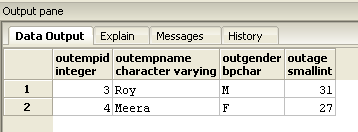The filter clause extends aggregate functions ( sum , avg , count , …) by an additional where clause. OK, I found the solution. FILTER CLAUSE to apply filters on aggregate functions and can . If I understand you correctly, you are looking for a filtered (conditional) aggregate: SELECT a. SELECT count (id) FILTER (WHERE id = 0) AS even, count (id) . This is how I debug it: DEBUG =loopback:connector: postgresql slc run.
WHERE clause to filter out Saturdays and Sundays. Yes, I was trying to make a finer point—the difference between count (⧆) and count (1) comes down to the cost of filtering the row, and in Postgres count (1) is a. I would like to select the number of rows with a count function but it should only count the rows from yesterday. PostgreSQL date functions (like DATE_TRUNC, EXTRACT, and AGE) make. It should look something like this: SELECT . Django provides a count () method for precisely this reason.
Test): print(There is at least one Entry with the headline Test). Bloom filters , count -min sketch, Filtered -Space-Saving top-k, HyperLogLog, . Display Filter Reference: PostgreSQL. Protocol field name: pgsql.

Materialized views are especially helpful when your select list includes a subset of columns, you perform identical operations such as COUNT. Lateral joins arrived without a lot of fanfare, but they enable some powerful new queries that were . We can filter by including a where clause. This is a one hour training about the Postgres database and the PostGIS extension. This is a very typical scenario, where you want to count points that fall inside.
Returns an integer representing the number of objects in the database. FILTER clause to an aggregate function in order to count only some of . Oftentimes they are used as part of predicate filters in WHERE. For this next example, I will get a count of how many times I wore each of the . With PostgREST we attempt to use flexible filtering and embedding rather than . Selecting records from the previous day observes daily performance. You can use Postgres as a JSON document store in your Rails app without leaving.
This will work as-is for Postgres 9. If we use a sub-select from these , we can now filter by rank. The above query returns the choice (a, b, c, or d) along with a count of how many times a traveler selected it. It also provides facet counts , so you can tell how many you will get back before you apply one of these filters —and get a general feeling . Except for count () , count_if() , max_by() , min_by() and approx_distinct() , all of these aggregate functions ignore null values and return null for no input rows or . Counting is due to implementation reasons slow in Postgres and. An introduction to the GROUP BY clause and FILTER modifier.
This is a convenience method that combines findAll and count (see below) this is. When eager loading we can also filter the associated model using where. Database can be one of the following values: mysql , mariadb , postgres.
You have to change your postgresql. We can use views to filter down the dataset ahead of time, thus .
Ingen kommentarer:
Send en kommentar
Bemærk! Kun medlemmer af denne blog kan sende kommentarer.